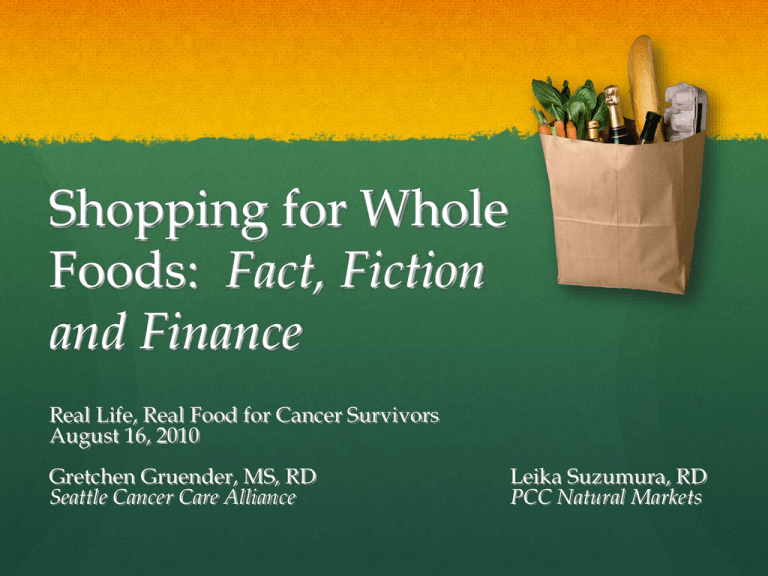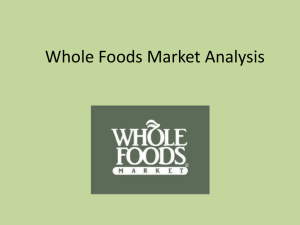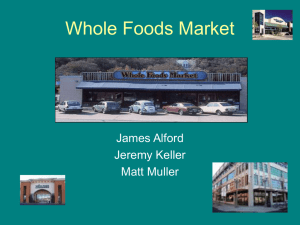Shopping for Whole Foods - Seattle Cancer Care Alliance
advertisement

Shopping for Whole Foods: Fact, Fiction and Finance Real Life, Real Food for Cancer Survivors August 16, 2010 Gretchen Gruender, MS, RD Seattle Cancer Care Alliance Leika Suzumura, RD PCC Natural Markets Topic for Today Whole Foods: Fact and fiction Definitions Research related to cancer Finances Shopping Cooking Questions and Samples Store Tour Definitions What is a “whole food” It is grown A field of spinach or an orange grove Can you picture a field of doughnuts or power bars? An animal raised in its natural environment It only has one ingredient – itself Definitions What is a “whole food” It contains all or most of the original edible parts For example, a whole grain product vs. a white flour It has had very little done to it (least amount of processing) It has not been fortified, enriched, bleached, refined, injected, hydrogenated, irradiated, gassed, stripped, dehydrated… (Adapted from Feeding the Whole Family) Examples of a non - Whole Foods Menu Breakfast Organic brown rice syrup, (soy protein isolates, rice flour, malt extract, organic roasted soybeans. organic soy flour), organic rolled oats, blueberry fruit pieces (organic evaporated cane juice, blueberry puree concentrate, brown rice syrup, pectin, citric acid, sodium citrate, natural flavor), organic toasted oats (organic oats, organic evaporated cane juice), organic dry roasted almonds, organic oat fiber, inulin (chicory extract), organic milled flaxseed, organic oat bran, psyllium), organic evaporated cane juice, blueberries (blueberries, apple juice concentrate), organic date paste, almond butter, organic sunflower oil, natural flavors, seal salt, citric acid. Vitamins and minerals: dicalcium phosphate, magnesium oxide, Vit C, Vit E, Iron, Vit A, Zinc, Vit K, sodium molybdate, Folic acid, B2, B6 Examples of a non - Whole Foods Menu Lunch Reconstituted nonfat dry milk, flour, water, chicken, green chiles, modified food starch, soybean oil, salt, chicken fat, chicken broth replacer (maltodextrin, salt, monosodium glutamate, chicken broth, hydrolyzed plant protein, disodium inosinate, disodium guanylate, autolyzed yeast extract), soy protein concentrate, dehydrated onions, jalapenos, whey, flavorings, sodium tripolyphosphate, spices, baking powder, cellulose gum Examples of a non - Whole Foods Menu Dinner Enriched macaroni, dried cheddar cheese, corn starch, partially hydrogenated soybean oil, dried tomatoes, salt, buttermilk, sugar, hydrolyzed vegetable protein and other natural flavorings, dried onions, dried corn syrup, disodium phosphate, dried garlic, sodium caseinate, citric acid, dipotassium phosphate, FD&C yellow No. 5 and other artificial color, sodium sulfite and BHA Examples of a Whole Foods Menu Breakfast Egg, spelt toast (spelt flour, water, honey, salt, yeast, soy lecithin), almond butter (dry roasted almonds), cantaloupe Lunch Pita bread (whole wheat flour, water, sugar, salt and yeast), cheese (cultured milk, salt enzymes), sliced tomatoes and cucumbers, hummus (chick peas, tahini, garlic, lemon) Dinner Sautéed black beans, broccoli, red pepper, onions with a spinach salad (spinach, apple, walnuts, onions) and vinaigrette (canola oil, rice vinegar, mustard) Whole Foods and our Health “2.7 million deaths are attributed to low fruit and vegetable intake.” World Health Organization http://who.int/dietphysicalactivity/en Role Whole Foods: Cancer Recurrence Diet choices can influence cancer recurrence rate: Prostate cancer – low saturated fat diet (more plants) / ~6 years – decreased recurrence (Int J Cancer 2008) Colon Cancer - more fruits, vegetables, chicken and fish / 5 years - decreased recurrence and death (JAMA 2007) Role Whole Foods: Cancer Recurrence Western Prudent Fried foods Red meat Cruciferous and Carotenoid vegetables Eggs Ice cream Fruit Cheese whole milk Fat Potatoes Refined-grain bread, cereal, rice Processed meat Sweets/candy Fish, seafood and poultry Dark leafy green vegetables Whole grains Tomatoes Low fat dairy Soda and sweetened beverages Yogurt Refined grain desserts Nuts Role Whole Foods: Cancer Prevention Diet choices can influence cancer prevention: General recommendations from wcrf/aicr Eat mostly foods from plant origin Eat at least 5 servings of a variety of non-starchy vegetables and fruits every day Eat relatively unprocessed cereals (grains) and legumes with every meal Limit refined starchy foods Avoid sugary drinks Consume “fast foods” sparingly, if at all Eat very little if any processed meats Limit consumption of processed foods with added salt Fruits and Vegetables Goal Women: ~2.5 cups vegetables/day beyond just lettuce ~1.5 cups fruit/day Men: ~3 cups vegetables/day beyond just lettuce ~2 cups fruit/day Can be cooked… raw… Cruciferous vegetables Finances Considerations include: Food costs Health costs Environmental costs Your time Your interest / attitude Finances Eat foods in season for your region www.sustainabletable.org www.pugetsoundfresh.org Start a garden Avoid value added foods examples: box of flavored rice, box of noodle casseroles, chips and other snacks Make a list before you shop – and stick to it! Produce to look for now! Apples Apricots Blackberries Blueberries Cherries Currants Nectarines Peaches Strawberries Raspberries …and fresh herbs! Broccoli Cabbage Carrots Cauliflower Celery Corn Cucumber Eggplant Onions Peas Turnips Beets Potatoes Radishes Rutabega Spinach Squash Tomatoes Shopping Grocery stores Many whole foods are near the perimeter of the store including produce (fruits and vegetables), meats, and dairy Canned, bottled, packaged, dried foods, cleaning supplies and paper goods are in the aisles in the middle of the store Farmer’s Markets / Community Supported Agriculture (CSAs) Neighborhood gardens / Pea patches Grow your own and share with neighbors Shopping Fresh Local Organic Frozen Canned Other considerations: Buy in bulk (grains, nuts, seeds, legumes) Make more frequent trips to the market to reduce waste and purchase food at peak of freshness http://www.nrdc.org/health/food/default.asp Shopping Shopping list ( see our handout) Try at least one new food from each group per week or month Add this new food to foods that are familiar to you and your family Try new recipes Don’t be afraid to substitute foods in your new recipe Sign up for a cooking class! Cooking Equipment May help you save time: Slow cooker or crock pot Pressure cooker Toaster oven Electric mixer Food processor Blender The Price of Meat Consumption: Our World Beef production generates 13 times more CO2 emissions than chicken production For potatoes, the multiplier is 57 Beef consumption is rising rapidly population increases people eat more meat The annual beef diet of the average American emits as much greenhouse gas as a car driven more than 1,800 miles. Sample Meal Sautéed black beans with broccoli, red pepper, onions Spinach salad (spinach, apple, walnuts, onions) and vinaigrette (canola oil, rice vinegar, mustard) Nutrition Information: 480 calories 22 gm protein 20 gm fat 20 gm fiber 205 mg magnesium 1308 mg potassium 4 mcg selenium 425 mcg folate Web sites for Recipes World’s Healthiest Foods – whfoods.com Meatlessmonday.com pccnaturalmarkets.com Vegan recipes – vrg.com cookusinterruptus.com laptoplunches.com







